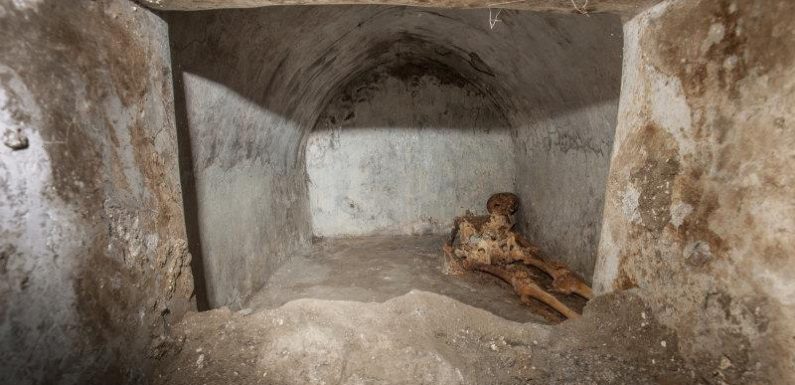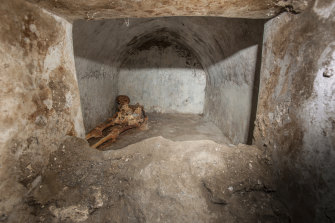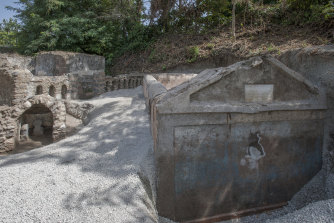
Rome: Archaeologists have uncovered a well-preserved skeleton at a burial site in Pompeii which has shed new light on funeral rites and cultural activity in the doomed, ancient Roman city, officials say.
The body of the man, believed to be in his 60s, was found in a tomb that dated to the final decades of Pompeii, before it was destroyed by the Vesuvius volcano in 79AD.
Archaeologists in Pompeii have discovered a remarkably well-preserved skeleton during excavations. Credit:Pompeii Archeological Park via AP
A commemorative inscription named the man as Marcus Venerius Secundio and made a reference to theatre performances at Pompeii in Greek – the first time archaeologists have found direct evidence of plays performed there in Greek as well as in Latin.
“That performances in Greek were organised is evidence of the lively and open cultural climate which characterised ancient Pompeii,” said Gabriel Zuchtriegel, director of Pompeii’s Archaeological Park.
The park said in a statement that it was one of the best preserved skeletons ever found at the site and showed signs of partial mummification, with hair and an ear still evident on the skull. Two cremation urns were also found in the tomb enclosure.
Adults were normally cremated in the city at the time, so the burial of Marcus Venerius is seen as highly unusual.
Archaeologists are investigating whether the man might have been embalmed ahead of burial. Certain textiles are known to have been used in embalming and archaeologists have found fragments of what might be fabric at the site.
The tomb of Marcus Venerius Secundio, located in the necropolis of Porta Sarno.Credit:Pompeii Archeological Park via AP
Marcus Venerius’s name appears in another city archive, which identified him as a public slave and a custodian of the Temple of Venus. He was later freed and his imposing tomb suggests he had reached a certain social and economic status before his death.
The burial site is not currently accessible to visitors and lies beyond the city limits. Pompeii officials said they were looking into how they could open the area to the public.
Pompeii, 23 kilometres south-east of Naples, was home to about 13,000 people when the volcanic eruption buried it under ash, pumice pebbles and dust, freezing it in time.
The site was not discovered until the 16th century and organised excavations began around 1750. A recent burst of archaeological activity, aimed at halting years of decay and neglect, has enabled scholars to uncover areas that have previously remained buried under the volcanic debris.
Reuters
Get a note direct from our foreign correspondents on what’s making headlines around the world. Sign up for the weekly What in the World newsletter here.
Most Viewed in World
From our partners
Source: Read Full Article

